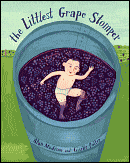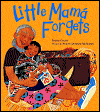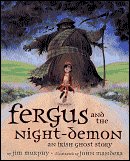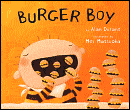Two lovely grandparental tales with an original folk tale, cautionary tale, and tall tale to boot
 February 17th, 2007 by jules
February 17th, 2007 by jules
 The Littlest Grape Stomper
The Littlest Grape Stomperby Alan Madison and illustrated by Giselle Potter
Release date: February 27, 2007
Random House
My source: review copy
This is a bizarre, little tale that seems to be just the perfect fare for Giselle Potter. Ever wonder how the five Grape Lakes were formed? Wonder no further. Alan Madison is here to tell you. Enter the tiny village of Ear (unless I’m missing something big here, there is no rhyme or reason as to why it’s named Ear, but you can at least enjoy Potter’s opening spread in which Ear’s countryside turns into its downtown with buildings circling one another not unlike a cochlea). With a sparkling little rhythm, much alluring alliteration, and a pleasing degree of lyricism, Madison tells us that this tiny village, “nestled snugly in the Your Valley,” was known for making delicious grape juice. Living in the inner part of ear (ba-dum-ching) was a young lad named Sixto Poblano — “Sixto,” because he was born with six toes on each foot. He hates it, and he gets made fun of. But then “the big head of all things grape,” Boss Nova Boombatz, shows up and sweet-talks his way into getting Sixto to stomp on some grapes. In “eye-popping, jaw-dropping astonishment,” the other grape-stompers see that Sixto need only stomp a couple times, and voila! them grapes are now grape juice. Things get a bit out of hand, as Boombatz gets grand visions of building even bigger bulky barrels and titanic tubs in which he will convince Sixto to stand and stomp. “I’d rather play, sir,” Sixto keeps telling him . . . I won’t give away any more spoilers except to say that, in the end, we have another tale to add to the accept-your-differences collection of picture books, though Madison does things up nicely with much humor and style and mellifluousness (yes, I actually just said mellifluousness — isn’t it a fun word?) and heaping doses of the aforementioned alliteration and lighthearted rhythms that make this one a lovely read-aloud: “The boy watched the villagers pick and pluck the plump purple clusters off the vines. When their baskets were full, they poured the ripe rounds into wooden barrels.” Potter is at her usual level of excellence with her rather neo folk-art illustrations (rendered in pencil, ink, gouache, gesso, and watercolor), this time with many deep blues and purples and lovely verdant greens. And, as Emily Jenkins put it well in our recent interview with her, “{Potter} conveys great joy coexisting with melancholy in a wonderful way.” She pulls that off once again in this quirky, new story to add to your tall tales collection.

by Robin Cruise and illustrated by Stacey Dressen-McQueen
March 2006
Farrar Straus Giroux
My source: library copy
This is a loving story of a modern Mexican-American family but with a spotlight shined on Little Mamá, the grandmother, and Luciana, her young granddaughter. And with an opening line like “Luciana Maria Isabela Galvez-Molinero. My grandmother’s name is a quiet morning song . . .”, how can you not love this book? Little Luciana, “Lucy,” knows that her grandmother forgets some things (forgets to wake up with the sun, forgets the bread she is toasting, forgets how to tie her shoes), but she remembers what is truly important: to pour rivers of cream on Lucy’s rice pudding at breakfast, how to button her favorite dancing shoes, how to skip like Lucy showed her. Little Mamá and Lucy are tight, and Lucy knows all of Mamá’s stories by heart — stories of “the village where she and her brothers and sisters picked fruit and played in the sun . . . And when Little Mamá talks about that village, I can almost see her climbing trees and chasing chickens in sunny Tembabichi.” Compassion and familial devotion permeate every word of the tale, and Dressen-McQueen’s folk-art illustrations bring to life this Hispanic culture with bold colors and much detail (case in point: the gorgeous spread in which Little Mamá and Lucy open Mamá’s old trunk to play with the shawls and fans and ruffled skirts of Little Mamá’s past). Spanish words are interspersed throughout the text as well (with a lovely “duermete mi nina” written across one of the final illustrations in which Mamá is putting Lucy to bed). This is a spot-on story of the love between a grandparent and grandchild: “Almost every day, Little Mamá forgets . . . names and places and people and words. She forgets so many things she once knew. But my pretty grandma, my bonita abuelita, always remembers . . . to tuck me in with a song and a kiss.”

byAnette Bley
March 2007
Kane/Miller
My source: review copy
More beauty and loveliness from the fabulous folks at Kane/Miller who bring international authors and illustrators to our attention. This stirring story, another affecting tale about a grandparent and grandchild (although it’s altogether arguable they could not be related), was originally published in 2005 in Germany and now is being published here in the States as the first American edition. Otto and Lisa are extremely close. They sit and tell stories together outside, play with the slingshot Otto made for Lisa, share “emergency cookies,” rake freshly mown grass together, and — in one beautifully-rendered spread — watch the first stars appear, one by one, “until the whole sky glitters and gleams.”
“How many stars do you think there are?” Lisa asks.
“A thousand,” Otto answers, “or maybe even more.”
“And what comes after a thousand?” Lisa wants to know.
“One thousand one, one thousand two, one thousand three, one thousand . . .”
“But don’t the numbers ever stop?”
“No, numbers never end.”
Bley expertly uses the first half of the book to establish the loving connection between Otto and Lisa. Suddenly, though, Otto is too tired to get out of bed. With refreshing directness, Bley’s curious, young protagonist asks him, “{w}ill you die soon?” . . . “Mhmmm,” Otto nods, “I think so.” This is followed by two exquisite spreads that you just need to see for yourself in which we’re told and shown that sometimes Lisa just holds Otto’s hand and then the heart-rending spread in which Otto dies, both beautifully illustrated and written. Bley’s illustrations are a wonder. At Otto’s funeral, Lisa is one of the only spots of color in her bright, crimson dress, surrounded by mourners in grey (“lots of people . . . Lisa has never seen . . . before . . . and they all look terribly serious. ‘Don’t whisper like that!’ Lisa shouts at them. ‘Otto doesn’t like whispering!'”). But how Lisa and her mom quietly come to terms with Otto’s death in their own way is a lovely experience I won’t spoil for you. Publishers Weekly puts it well: “German author-artist Bley’s velvety, emotionally acute pictures exude a visual poetry. She conjures a world where minds can meet across the generations without impediments. The scenes of Otto’s swift decline are unsparing, but also intensely human, softened by images of poppies and the things Lisa brings to Otto (leaves, cocoons); every detail seems authentic and heartfelt.” Word. Another beautiful book from Kane/Miller. Don’t miss it.

by Jim Murphy and illustrated by John Manders
September 2006
Houghton Mifflin Company
My source: library copy
Treat yourself to this original tale by Jim Murphy that is a spirited nod to Irish folklore. In his author’s note at the book’s close (yay for authors who include those), he tells us that the book’s antagonist, the Night-Demon, is “a combination of the dreaded Dullahan, a headless phantom who takes his victims off in a black coach, and a particularly mean collection of goblins known as air-demons, who inhabit the clouds and mists.” Fergus, our brash, young protagonist, is as lazy as they come, repeatedly turning down his wearied mother’s requests for help with the chores. “You are a lazy, good-for-nothing,” his mother scolds. “One day you’ll answer for your ways.” “Perhaps, Mother,” said Fergus, “but tonight I’m off to Skibbereen for a bit of play.” Needless to say, he meets the Night-Demon on his way, who is intent to send Fergus to his grave (with a tombstone already prepared: “here lies Fergus O’Mara, A Lazy, Good-for-Nothing Lad”). How he outwits the Night-Demon and how it affects his attitude at home is for you to find out. Manders’ gouache and colored pencil illustrations are fun, the Night-Demon created in an effectively chilling manner, making this picture book a read for the slightly older set. His interesting perspectives — when Fergus has invoked the utmost wrath from the angry Night-Demon — and ability to create riveting suspense with them are a sight to see.

by Alan Durant and illustrated by Mei Matsuoka
October 2006
Clarion Books
My source: library copy
What a wild ride this one is, another peculiar yet magnetic, little tale. And it’s another bold-faced cautionary tale (see recent Ugly Fish review) in which a young boy, Benny, turns into the only food he will eat — burgers. Yes, in one illustration, he’s stuffin’ his face with nineteen of those things. How do I know this? My emerging three-year-old cannot hear this book enough. In fact, I didn’t care much for it on the first read, but her requests for repeated readings made me think twice (and thrice and, um, quince and, well, you get the picture). Benny’s mother warns him that he will turn into a hamburger if that’s all he eats, and lo and behold, my friends, he does! The poor lil’ tyke gets chased by dogs and other children (“It’s burger time!” they scream in chilling unison, thus making my wee daughter laugh hysterically). And vegetarians everywhere will chuckle when he runs to a herd of cows, mistakenly assuming he’ll be safe. “Don’t you know what burgers are made of?” they moo and snarl at Benny, angrily. “I’m not a burger, I’m a boy! Leave me alone!” is his refrain. Everyone’s chasing poor Benny, and just when you think it can’t get any worse, he is put on display as a giant burger at Bigga Burgers, his favorite restaurant. Did I mention this little tale is a bit freakish in a wonderfull creepy way? After his mother finds him and scoops him up, he pledges to never eat another burger and ends up eating way lower on the food chain — only fruits and veggies, to be exact. And then in the end we’re given a slight twist on things; you’re beginning to wonder if this isn’t some delightfully subversive vegetarian propaganda when Durant throws us a curve ball at the book’s closing, showing he’s an equal opportunity offender of sorts. Matsuoka’s illustrations — executed in colored pencil, acrylic, and cut paper and sometimes evoking the look of John Segal — are full of comic touches for the observant eye.

The Littlest Grape Stomper sounds like something Lucy Ricardo would read to Little Ricky. 😉
[…] illustrated (she has illustrated three picture books previous to this one, one of which I reviewed here last year). Wolf becomes Mr. Nice Wolf in his story. He’s following the footprints of an […]
[…] belt. I’m a fan of her work (in fact, I reviewed one of her illustrated titles at 7-Imp back here in ‘07), but I had assumed, as I’m wont to do, that there existed a big long line of […]
[…] “…beautifully illustrated and written..don’t miss it.” – Seven Impossible Things Before Breakfast […]